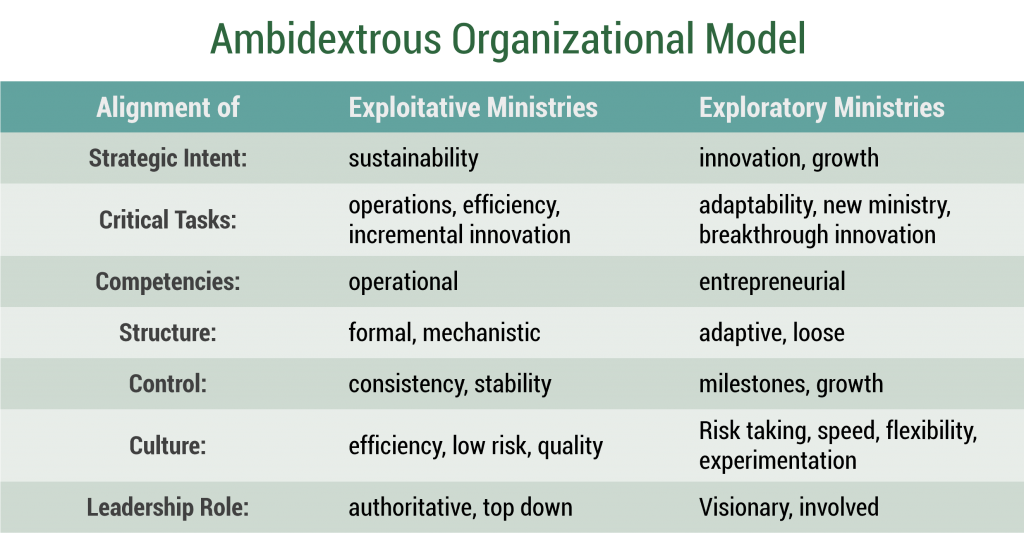Community centricity is the prime focus of cultural transformation. It becomes a matter of survival for those churches hit hard by the “Nones and Dones” and helps them keep their values and beliefs for the community. Many technology-based venues of getting closer to your community can help reduce the risk of guessing what’s working in your emerging ministries before launching them and seeing if your aspiration is correct. Community-centricity extends far beyond our efforts to find new emerging evangelism. It should be a foundation that drives all core decisions across all areas of the ministry. The community-centric culture anticipates emerging relevant interactions with a neighboring community by dynamically integrating their demographics and underserved needs, initial experiences, and feedback from the early adopters who have participated in your JIT ministry project.
Shattering ministry silos
The traditional churches are notorious for organizational silos and rigid structure that makes the silos untouchable. The latest church structures were defined at the time of the peak of its expansion, probably even before the 20th century. The mainline churches inherit the traditional organizational models, such as line, functional, or a combination of them. High levels of hierarchy do exist among them. Typically, various committees laterally do their functions, meaning they seldom respond to each other. The organizational structure of autonomous subsectors naturally introduces silos in time. There were many efforts and articles about dismantling silo mentality and behaviors, but not many took approaches from the organizational models.
The business sectors successfully broke down the silos naturally by creating and adopting new organizational models. One of the most effective structures is the Ambidextrous organization model that first appeared in 2004 on HBR. It asserts that two organizational models should coexist in an organization: one hierarchical very similar to the traditional church structure, linked to the “management” part of operations focusing on stability and control. The other focuses on the more innovative and explorative nature of business.  This model sums up two existing and adds them to the traditional organizational model. The first one is the Project-based model, which tries to gain flexibility in allocating resources generally held by functional subsectors, like church committees. The second one is the Network model (Hixon, 1989), which shows the informal organization patterns. The Network model acknowledges that you can’t run your organization linearly from strategy to structure, staff, resources, etc., especially in the emerging digital world. It focuses on the iterative process in which you discover a team to meet a strategic need, develop a specific context-based strategy, reorient the system (I will revisit the system theory for effective congregational development in a new post,) and reorganize the team as necessary. The structure is fluid and temporary. The organization should be capable of changing its structure nimbly to respond to unique needs and target contexts.
This model sums up two existing and adds them to the traditional organizational model. The first one is the Project-based model, which tries to gain flexibility in allocating resources generally held by functional subsectors, like church committees. The second one is the Network model (Hixon, 1989), which shows the informal organization patterns. The Network model acknowledges that you can’t run your organization linearly from strategy to structure, staff, resources, etc., especially in the emerging digital world. It focuses on the iterative process in which you discover a team to meet a strategic need, develop a specific context-based strategy, reorient the system (I will revisit the system theory for effective congregational development in a new post,) and reorganize the team as necessary. The structure is fluid and temporary. The organization should be capable of changing its structure nimbly to respond to unique needs and target contexts.
Collaboration is a new ministry strategy
Since you can’t change your inherited church structure overnight, I want you to explore two main insights these new organizational models have brought. First, it introduces cross-functionality. It is a way to overcome the silo mentality. It would help if you introduced cross-functional teamwork opportunities in your local ministry settings. The pastors should facilitate all functional subsectors (or committees) to COLLABORATE for a simple ministry project. Why a simple project? Not many pastors have the experience or know-how to make the collaboration successful among various members of multiple committees for a project that lasts long. For example, a 5-year long building project costs a multi-million dollars. I’ve often heard things I don’t want to encounter from pastors who had to undergo long-term projects demanding high-level collaboration. Collaboration requires practice with more straightforward cases. If it were the project organized by a committee, I would have used “TEAMWORK.” Since it is a cross-functional project, I intentionally use this term. Collaboration takes a transcendence stance over structural authority and original accountabilities. It will lower the high ceiling of the silos.
The second insight is to expand the scope of collaboration and include community connectors in such collaboration. Your local community has survived and sustained in the emerging culture until now. What does it mean? It means that there are leaders and influencers in your area who have made it possible. Go beyond the four walls of your church building and collaborate with them for a simple community-centric project. Many pastors attempt to work with city mayors or other officials jointly. The connection may contribute a section to your church newsletter. Your name value may be heightened in your community. I am not saying it is a bad attempt. I suggest that you also get connected with individuals or small organizations that have operated in your area for the specific needs of the local people. Find and study them and offer collaboration if their value propositions align with your church’s missional values. I will write a new post about how to find and get connected with the local influencers soon. Collaboration is a new ministry strategy in today’s world, especially when your congregation is aging and doesn’t own enough cultural competencies required for fruitful community-centric ministries. The local influencers and community connectors will introduce the competencies and the network of people to the ministry projects.
Closing
Considering the 21st century, the traditional church model is old and ineffective. The organization’s purpose is not to control; it empowers a group of people to actualize their callings. For this reason, organizational structures become ever crucial for the missional purpose. Many have contributed to the Ambidextrous model to go farther than just lowering silos by adding constraints to the iterative element in the model, for example, as they focus on embedding Agile practices (Graves, 2011). I have designed the disruptive ministry diffusion framework incorporating the Agile iterative process into the congregational development. The leadership development framework is unique in allowing the church to co-organize community-centric ministries with community connectors. I have consulted a couple of dozen congregations to develop their ministries based on the framework for multiple years. I have found that the churches mobilize their stagnant ministries and successfully add the agile ministry development loop to their ministry strategy. Adding the practical, informal elements to the traditional hierarchical structure helps shatter the ministry silos. It creates opportunities for nimble ministry development based on the specific needs of the local community.
There still exists a problematic silo to be shattered. The closed-minded, parochial mentality of spiritual leaders who hesitate to acknowledge that they need help from the neighboring community to do “Church” today. An image found on the Internet depicts the situation of today’s churches very well. The gigantic tsunami caused by digital revolution swallowed all the ground holds, and a church is, as a result, isolated alone in the water.  Whenever looking at this picture, it reminds me of a hymn, “Throw Out the Lifeline across the Dark Wave,” composed by Reverend Edward Smith Ufford. He watched men throwing a lifeline to those struggling in the water and wrote the lyrics and melody to this hymn in 1988.
Whenever looking at this picture, it reminds me of a hymn, “Throw Out the Lifeline across the Dark Wave,” composed by Reverend Edward Smith Ufford. He watched men throwing a lifeline to those struggling in the water and wrote the lyrics and melody to this hymn in 1988.
Throw out the lifeline across the dark wave;
There is a brother whom someone should save;
Somebody’s brother! O who then will dare
To throw out the lifeline, his peril to share?
Throw out the lifeline! Throw out the lifeline!
Someone is drifting away;
Throw out the lifeline! Throw out the lifeline!
Someone is sinking today…
To continue saving the souls, can you see that the church in the picture desperately needs a lifeline from the neighboring community? A few good people in your area have successfully thrived in the digital revolution tsunami by overcoming the disruptions caused by it. You need to collaborate with these community connectors who will help you build a bridge across the dark wave.






